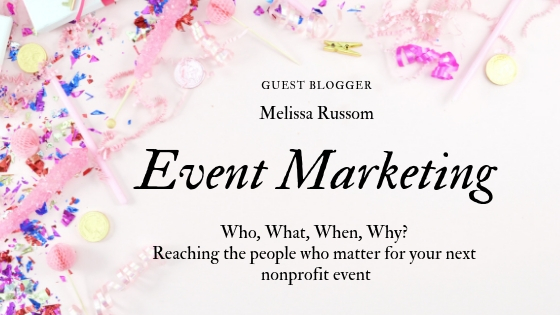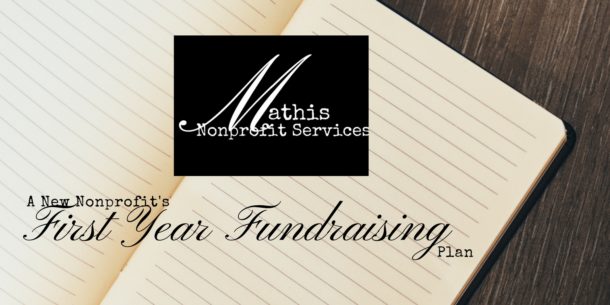Melissa Russom (https://melissarussom.com/) is a strategic communications consultant who empowers organizations to engage more meaningfully with the people who matter most to propel their missions forward. She is a guest blogger today and is digging into fundraising event planning with us.
So, you have your first event coming up…gulp.
It can be nerve-wracking. You’re counting on the event to bring in some revenue to support your nonprofit’s programs, but you aren’t an event promoter. How are you supposed to make this work?
First, understand there is no one-size fits all approach to event marketing. If you start by thinking about how to market your nonprofit event to your intended audience, you’re already ahead of the game. Creating a straightforward marketing plan, according to your specific needs and goals, will not only give you a game plan, it will provide a clear structure to galvanize other staff and board members to help market the event.
Consider the following when developing your plan:
Goals: A nonprofit event can do much more than raise money. It can act as a gateway for new potential supporters to get to know the organization. With the proper hook, a nonprofit event can attract valuable media attention for the organization. Also, it’s an opportunity for face-to-face conversations with your supporters – a chance to learn more about them and why they support you.
Audience: Who do you want to come? Depending on your goals, you are likely looking for more than just seat-fillers. Who will help you achieve your goals for the event: Corporate leaders? Families? Millennials? Religious leaders? Students?…
What do you know about your audience? Do they have common hobbies, gathering spaces, communications preferences (mail vs. email for example), or habits? What may prevent them from coming that you could address upfront? Brainstorming and researching (ask them) what makes your audience unique will help you better identify with them to effectively reach them.
About: What makes your event unique? How is it particularly enticing to your audience? Why should they come? Here is where you create your messaging so you (and everyone on your team) use consistent and deliberate descriptions whenever discussing the event.
Communications tactics: Don’t rely on a single person’s idea of marketing channels like email, social media, traditional advertising, etc. Bring together a committee (formal and ongoing or informal one-time) representative of your target audience to share ideas for how they generally find interesting news or events.
This is where you may find out that your audience is much more responsive to an ad in a church bulletin than they are to a Facebook event listing. Or, lawn signs in strategic locations may prove more effective than an ad in the local paper. It all depends on who you’re trying to reach. Be creative!
Budget: You’ve narrowed down which communications vehicles are the most appropriate for your audience and now comes the hard part: what can you afford? Your mix of tactics will depend on how much you’re willing to dedicate to marketing.
Some tactics are free, as long as your have someone with the knowledge to execute them. For example, can someone on your team coordinate with media outlets to request public service announcements (PSAs)? Is someone on the team social media savvy? Do you have a writer who can produce persuasive language?
Other tactics (direct mail and advertising) have an inherent cost.
Feedback: Your first event comes with a lot of unknowns. The good news is, each subsequent event will have fewer unknowns than the one before. When you’re collecting registrations, be sure to track how people came across the event. Your digital registration platform likely tracks some of this or you can simply ask the question following registration. Then, after the event (and even during), collect feedback about what went well, what could be improved and new creative ideas. Survey cards on the table, personal conversations, follow-up emails – these are all opportunities to gauge how effective your marketing has been.
Asking all of these questions will take much of the guesswork out of event marketing. By creating a plan, you will have a focused strategy that defines just how you plan to reach out to your audience. Your plan should include your ideal mix of tactics, messages, timeline, audience, budget and responsible team member. You don’t need something fancy – an excel spreadsheet can work wonders for a small organization!
As the person ultimately responsible for the marketing of the event, just remember: that does not mean you should be implementing every tactic. It means you should be directing the team to leverage the strengths and resources available to you to get everything done. Your plan is a helpful tool to assign tasks and hold the team accountable.
Just because you are not a marketer, does not mean you can’t have a successful event. You can think like a marketer, be strategic, and leverage a team.
If you need some help creating or executing your plan, feel free to email me at Melissa@MelissaRussom.com. I’m happy to answer your immediate questions or to discuss how I may be able to help as a support to your in-house team.
About the author:
 Melissa Russom empowers organizations, large and small, to engage more meaningfully with the people who matter most to propel their missions forward. Through strategic communications planning, she assists clients in designing an approach that is informed by goals, insights and resources, rather than assumptions and commonly deployed tactics.
Melissa Russom empowers organizations, large and small, to engage more meaningfully with the people who matter most to propel their missions forward. Through strategic communications planning, she assists clients in designing an approach that is informed by goals, insights and resources, rather than assumptions and commonly deployed tactics.
Offering services including strategic communications planning, content strategy, social media management, copywriting and presentation development, she ensures every action has a purpose.
Guest Blogger, Melissa Russom


 Most nonprofit leaders lay awake at night trying to figure out how to fund their mission.
Hi! I'm Alesha.
I teach sustainable fundraising in a way that they can take action today so they can serve their clients.
I can help you move from just getting started funding your new nonprofit to gaining confidence in your fundraising and building relationships to knowing what works for your organization and looking at the infinite game when it comes to funding. I’ve worked with nonprofit Founders and written the book I HAVE MY 501(C)3! NOW WHAT?!? Your Blueprint to Starting Your Nonprofit Without Being the Sole Funder that lays the foundations for funding in a new nonprofit.
I’ve worked in Development (Fundraising) Departments in large organizations and I know the no cost, low-cost methods they use to bring in funding. I bring those sound strategies to the nonprofits I serve.
Most nonprofit leaders lay awake at night trying to figure out how to fund their mission.
Hi! I'm Alesha.
I teach sustainable fundraising in a way that they can take action today so they can serve their clients.
I can help you move from just getting started funding your new nonprofit to gaining confidence in your fundraising and building relationships to knowing what works for your organization and looking at the infinite game when it comes to funding. I’ve worked with nonprofit Founders and written the book I HAVE MY 501(C)3! NOW WHAT?!? Your Blueprint to Starting Your Nonprofit Without Being the Sole Funder that lays the foundations for funding in a new nonprofit.
I’ve worked in Development (Fundraising) Departments in large organizations and I know the no cost, low-cost methods they use to bring in funding. I bring those sound strategies to the nonprofits I serve.